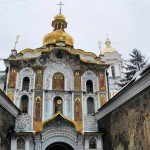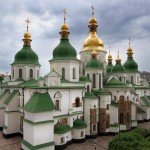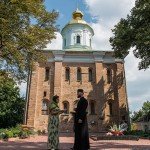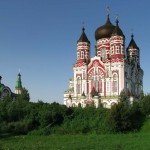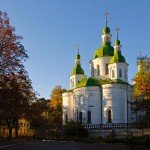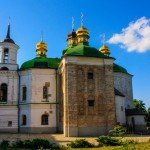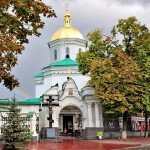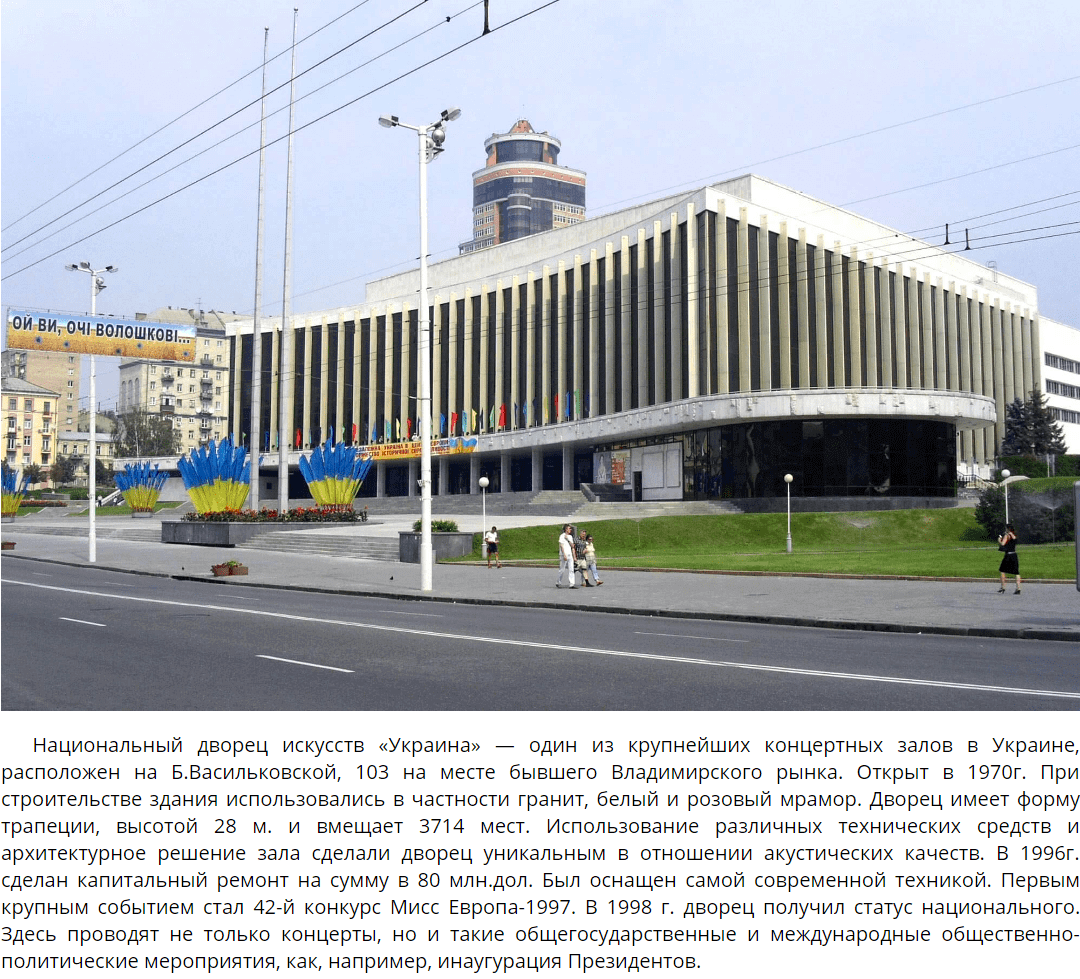Top 10 cathedrals in Kiev
- 1. Trinity Gate Church of the Kyiv-Pechersk Lavra
- 2. St. Michael’s Golden-domed Cathedral
- 3. The St. Sophia’s Cathedral
- 4. St. Michael’s Cathedral
- 5. St. Volodymyr Cathedral
- 6. St. Nicholas Cathedral
- 7. St. Panteleimon Cathedral
- 8. St. Cyril Church
- 9. The Transfiguration Church (Church of the Savior on Berestov)
- 10. Saint Elias Cathedral
1. Trinity Gate Church of the Kyiv-Pechersk Lavra – built in 1106-1108 as a part of the fortifications of the monastery, founded in 1051 by monk Anthony, who created here the first prayer communities, settling in the caves of the future Pechersk monastery. It is from the caves that the monastery takes its name. Since the end of XI century the territory of the monastery began to build up. The Assumption Cathedral, the Trinity Gate Church and the Refectory were built. The Trinity Gate Church was founded by the grandson of Chernigiv and Kyiv Prince Svyatoslav Yaroslavovych. Being the heir to the throne, the founder of the church refused from the prince’s title and took monastic vows, taking the name of St. Nicholas. The Trinity Gate Church is the only surviving land structure of the Kyiv-Pechersk Lavra. Art painting of the eastern and western facade is recognized as a unique valuable monument of Ukrainian art of the early 18th century. In the middle of the XVIII century was formed a unique architectural ensemble of the Lavra, which preserved to this day. The Kyiv-Pechersk Lavra became the largest monastery of Kyivan Rus, the area of which was about 30 hectares. The territory of the monastery includes near and distant caves. It should be noted that the bell tower is 96.5 m high, which until the 20th century was the highest building in Kyiv. Since 1990 is listed as a UNESCO World Heritage List. On the territory there are museums, unique shrines, in the caves – the relics of saints.
2. St. Michael’s Golden-domed Cathedral – is the oldest and greatest Orthodox shrine of Kyiv, founded by the grandson of Yaroslav the Wise, Svyatopolk Iziaslavovych the Prince on the territory of the Dmytriivskyi Monastery according to the chronicle in 1108 and it is dedicated to Michael the Archangel the heavenly patron. Originally, the temple was wooden, after several decades the church was rebuilt into a stone church. The name “Mykhailivsky” monastery was given likely, in honour of the patron saint of Kyiv – Archangel Michael. According to another version – the Mykhailivsky Monastery was founded by the first Kyiv Metropolitan Michael.
The name “Zlatoverkhyi” was granted due to the fact that it was the first cathedral with gilded domes made of solid gold leaf. After the Kyiv-Pechersk Lavra St. Michael’s Golden-domed Cathedral becomes the second place in Kyiv for pilgrimage. It contained the remains of several generations of Kyiv princes, which testifies to the significant role of the cathedral in the public life of the city and the state. St. Michael’s Cathedral is famous for its frescoes and mosaics, which the arts critics called a new trend in the evolution of painting of Ancient Rus. The most famous shrine of the monastery was the relics of the St. Barbara the Great Martyr, delivered by the wife of Prince Svyatopolk, the daughter of the Byzantine emperor Alexis, who baptized Varvara. In 1240 the monastery was looted by the horde of Khan Baty.
A new stage in the development of the Mykhailivsky Monastery became the XVII-XVIII centuries, the authority and influence of the monastery grew, at its disposal there were huge territories and villages (Borodyanka, Trypillya, Motovylivka, etc.). At the end of the XVIII century the monastery of St. Michael’s Monastery was opened, which was called “Theophany”. In the XIX century on the territory of the monastery there was a real hotel complex, which served for the pilgrims. To the beginning of XX century there were a lot of parishioners, great services were held. After the Pechersk Lavra Mykhailivsky Monastery occupied the second place in Kyiv in terms of the number of parishioners and pilgrims. In 1937 the Cathedral was blown up. Valuable mosaics and frescoes were transferred to Sofia Kyiv, but some masterpieces (the mosaic “Dmytro Solunsky”, the fresco “Saint Nicholas”, the upper part of the fresco figure Samuel, etc.) were taken outside of Kyiv. In 2000 the monastery was restored.
3. The St. Sophia’s Cathedral – the greatest architectural structure, built by Yaroslav the Wise the Grand Prince in 1037. It preserved until now not only the richness of ancient architecture, but also the picturesque decoration of the 11th century, mainly mosaics and frescoes. Religious and state ideas of that time were embodied in the artistic image of Sophia of Kiev. The ensemble of mosaics is decorated with the main altar of the St. Sofia’s Temple. Entering the Cathedral, the glance is captured by the majestic figure of the praying Virgin of Oranta (Divine Wisdom), located in the vault of the altar. Frescoes of St. Sophia’s Cathedral are an interesting source of information about the life of the prince’s court and that way of life. They are the only preserved collection of paintings from the period of Kievan Rus. There are graffiti, i.e. ancient Russian inscriptions, which are the most important document of the dating of murals, on the walls of the cathedral. Apparently, the central part of the building works was performed in the 40’s, and in the galleries – in the 60s of the 11th century. Along with the famous ensembles of Ravenna, Venice, Montreal, Daphne, Palermo, ancient Constantinople, they occupy a prominent place in the treasury of world culture. St. Sophia Cathedral is included in the UNESCO’s World Heritage List.
4. St. Michael’s Cathedral – the main temple of the Vydubytsky Monastery, founded in the XI century by the son of Yaroslav the Wise – Prince Vsevolod Yaroslavovych. The cathedral itself was laid in 1070 on the slopes of the Dnipro River and partially preserved until our days. In 1199, the temple was fortified with a retaining wall to protect against landslides. The monastery was not only a spiritual centre, but also the centre of the secular life of Kyiv – here princes held talks, scientists and chroniclers worked. In the XVI century because of landslides, part of the temple collapsed and was rebuilt in the XVII century by metropolitan Petro Mohyla. Up to now, there are two walls with a characteristic laying of the period of Kyivan Rus. In the 1970s during the restoration in the cathedral under a layer of frescoes of the XVII-XVIII centuries was discovered the painting of the 11th century. In 1696 -1701 years. St. George’s Cathedral was built in the monastery, where the relics of St. George, Barbara the Great Martyr, John, etc. are represented.Also, the Church of the Transfiguration of the Lord was built, which is famous for its unique carved iconostasis, made in the form of a family tree. Previously, there was a cemetery on the territory of the monastery. 13 graves have been preserved until now., among which are the graves of the famous teacher K.D. Ushynsky and the couple Khanenko. On the territory there is a well with healing water.
5. St. Volodymyr Cathedral – built in the Old Byzantine style in honour of Prince Volodymyr the Baptist. The length of the temple is 55 m, width – 30 m, the height of the cathedral with the cross – 49 m. The idea of creating a cathedral belongs to Metropolitan Philaret Amfiteatrov. Officially it is believed that the construction of the church was started in 1852 on the order of Nicholas I. By 1859, about 100 thousand rubles were collected. The original project was developed by architect I. Shtrom, but the project was too expensive. Further, the development of the project engaged architect P.Sparro.
The subsequent work on the planning of the cathedral was undertaken by the architect A. Beretti. It was under the project of A. Beretti that the cathedral was erected, and the first stone was laid down on June 15, 1862, on the day of the memory of Prince Volodymyr. Due to design shortcomings, the construction was suspended. In 1875, on the order of Alexander Nikolayevich, construction was resumed. The completion of the project was entrusted to R.Bergnard, all subsequent works were carried out by the architect V.Nikolaev, under whose leadership it was possible to complete the erection of the church. The construction was completed in 1882.
The original design of the interior of the church belongs to V.Nikolaev, but in 1885 the decoration design was handed over to A.Prahov. He also made some interior details (massive bronze doors with the image of Princess Olga and Prince Volodymyr). For finishing the iconostasis marble was brought from Italy, France, Belgium and Spain. The mosaic works were done by masters from Venice. The main value of the cathedral is unique paintings, thanks to which the temple received the status of a cultural monument. The design of the cathedral was attended by artists V.Vasnetsov, M.Vrubel, M.Nesterov. On the walls are depicted not only the faces of saints, but also historical stories “The Baptism of Prince Volodymyr” and “The Baptism of Kyiv”, as well as portraits of Alexander Nevsky, Andrii Bogolyubsky, Princess Olga. The main beauty of the cathedral is V.Vasnetsov’s work “The Virgin with the Child” in the centre of the altar. In the 1930s. the relics of St. Barbara, brought to Kyiv by Prince Svyatopolk and kept in the Mykhailivsky Monastery, were transferred to the cathedral.
6. St. Nicholas Cathedral – is the largest in size church in Kyiv, built in 1896-1911. It is located on the territory of the Holy Protection Convent, founded in 1889. Russian princess Alexandra Romanova – the wife of the third son of Emperor Nicholas I and the aunt of the last Russian emperor Nikolai II. The cathedral was considered to be the largest church in Kyiv. Having a length of over 53 m and a width of up to 38 m, the cathedral housed more than 2 thousand pilgrims. In addition, the temple has a basement with an underground church. The cathedral is a unique work of art. In the temple there are unique shrines.
7. St. Panteleimon Cathedral – the main temple of the female St. Panteleimon Monastery, located on the territory of Theofany. The construction of the cathedral is in the period of 1905-1912. Before the revolution there were 4 churches – the Miracle of the Archangel Michael, All Saints, the Volodymyr Icon of the Mother of God and the Cathedral of the Great Martyr Panteleimon. In 1919 the lands of the monastery were nationalized, a state suburban agricultural enterprise was organized on the territory, later – medical institutions, the main astronomical observatory and the field experimental laboratory. In the post-war years, the experimental platforms of the Institute of Mechanics of the Ukrainian SSR’s Academy of Sciences were located here. The object was referred to the category of higher secrecy. Today St. Panteleimon Cathedral is an architectural monument. On the territory of the monastery there are healing springs, to which every day many believers and pilgrims come.
8. St. Cyril Church – the second church after St. Sophia Cathedral, preserved from the times of Ancient Rus in its original form. It is a unique monument of architecture and monumental painting. The church was founded by the prince of Chernigov Vsevolod Olgovich in the first part of the 12th century and was the ancestral family vault of the Olgovichi. The church is named after St. Cyril, the patron of the prince. According to the origins the first burial place (of Vsevolod’s wife) dates back to 1179. In 1194 the prince of Kiev Svyatoslav Vsevolodovich was buried here. Frescoes of the 12th century, paintings of the 17th century and oil frescoes of the 19th century still exist in this church. During the restoration in the 17th-18th centuries the church acquired the features of Ukrainian Baroque. Nearly 800 square meters of Old Russian frescoes, which have no analogues in any of the monuments of the Orthodox Christianity, have been preserved till this time. A special place among the oil paintings made during the restoration in the 19th century takes the works of the famous Russian artist Mikhail Vrubel, whose Mother of God is compared with the Sistine Madonna. There are a lot of excursions in the church every day.
9. The Transfiguration Church (Church of the Savior on Berestov) – one of the oldest churches in Kyiv, it is located near the Kyiv-Pechersk Lavra. Being outside the Lavra, the church is still considered to be a part of the historical complex related to the World Heritage. The name of the church comes from Berestovo village, which used to be here (now it is the territory of the Glory Park). The village was a suburban estate of Kyiv princes. According to the annals, the church was built by Volodymyr Monomakh in the beginning of the XII century as the main cathedral of the Transfiguration Monastery, because it is the residence of princes of the Monomakhovich family. Not only the representatives of princely family are buried here, but also Yuri Dolgoruky, Gleb Yuryevich, the Prince of Kyiv. In the XVII century at metropolitan Petra Mohyla, the Athonite masters were invited to work on the murals of the church. In the XVIII century the temple was reconstructed, and in the XIX century was completed the bell tower. In the 1980s during the excavation, about 80 different graves were discovered. The Church of the Savior on Berestov has been listed in UNESCO World Heritage List since 1990. Until now, not only the church itself, but also its interior with the ancient frescoes of the XII century, has survived.
10. Saint Elias Cathedral – was the first mentioned in 1632. It is considered to be the first Orthodox church of Kyivan Rus. According to the legend, the temple was built by Askold and Dir the Princes. There is a version that the baptism in 988 occurred near this temple. The stone church was built in 1692 by Kyiv petty bourgeois Petro Gudyma. The temple suffered greatly during the fires of 1718 and 1811. In the 1930s the St. Elias Cathedral was closed. The placement was handed over to the warehouse for grain. In 1941, when Kyiv was occupied by German troops, divine services were resumed in Elias church. Since that time, the doors of the temple have always been open to believers. In 1957, in a church under a layer of the 19th century painting, the fragments of the 18th century paintings were found, which were successfully restored. Most of the paintings in the interior of the church, preserved to this day, were made after the fire at Podil in 1811. The remains of the previous painting were preserved only in the altar part of the church. At present, the St. Elias Cathedral is an architectural monument.





